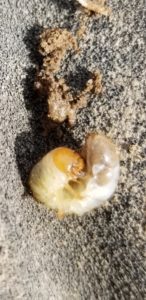Recently I had to remove some turf to extend a garden of shrubs. I’m hoping the shrubs will act as a snow fence in the years to come so I don’t get snow drifts blocking my drive.
Peeling back turf revealed lots of things: tiny roots from the removed grass, lots of varied-sized stones and pebbles, and many little white grubs
I knew I would likely find grubs. After all, skunks have been digging holes in the lawn for weeks, sniffing them out for their dinners. If I had a severe infestation, my lawn might feel spongey from these little beasts chewing on grass roots. Fortunately I don’t have enough grubs to make a difference in lawn quality. Grubs may also eat roots of some vegetables if found in a vegetable garden. Grubs are the larvae of beetles.
Having hatched from eggs laid in the soil during the summer, larvae go through three instars (developmental stages) and pupate before becoming the adult beetle you might recognize. Japanese and chafer beetles take one year to mature, but June bugs take two or three years to mature. Yes, grubs do hibernate by burrowing deeper into the soil when winter arrives.
I prefer to wait for beetles to emerge for easier identification. Japanese beetles are the ones I most often see. The metallic green-headed, brown-winged adults with white dots ringing their bodies love to chew on leaves of about 300 different kinds of plants. They really liked my grape leaves, for instance. Beetles emit a pheromone when feeding which in turns draws more of their kin to your garden. Picking beetles off foliage early in the morning and dumping them into a pail of soapy water will reduce the adult population. Some people like to use beetle traps, but Penn State Extension entomologists and horticulturists do not recommend pheromone traps because they draw even more beetles to your property.
If you would like more information about these beetles, you can start by reading articles by Extension educators. https://extension.psu.edu/white-grubs-underground-marauders-in-turf


